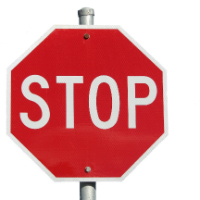 WAIT, BEFORE YOU SCROLL DOWN! While I know a lot about cars, I don't know a lot about YOUR CAR! A repair manual is essential and I have a way for you to get one FREE.
WAIT, BEFORE YOU SCROLL DOWN! While I know a lot about cars, I don't know a lot about YOUR CAR! A repair manual is essential and I have a way for you to get one FREE. Click Here To Read More(Link opens in a new window)
On The Road
Car Sagging?
A broken spring or shock can create a dangerous handling situation. Do not attempt to drive your vehicle, as braking and cornering may be affected. Pull off to a safe spot and call a tow truck.
ABS light going off during hard stops or on rough roads?
Worn shocks or struts can cause the wheels to bounce under braking and will engage the ABS system prematurely. A clean sign you need to replace those worn shocks or struts.
The Suspension System

When to replace struts and shocks on your car.
Your suspension soaks up the bumps in the road, keeping you comfortable and safe by allowing your brakes and tires to work as designed. Let's look at the major components and then talk a little about what can go wrong.
Spring:
Springs allow your car to absorb the energy of a bump or pothole, without jarring the occupants of the car. Most cars have 4 springs made from spring steel (huh imagine that!) and wound in a spiral shape. Some cars (Corvette) have transverse (across) springs and are made from fiberglass or other composite materials. Made to last the lifetime of the vehicle, properly sized springs seldom need to be replaced.
Shock:
Shocks work to dampen the springs natural tendancy to oscillate. A good way to test your shocks is to push on a corner of your car and observe how many times the car bounces. More than twice and your shocks are worn. The shock is designed with fluid and internal passages to control the movement of the wheel and dampen the spring, over time the fluid can leak, degrade or the valving can become damaged.
Strut:
Just a fancy unit that combines the spring and shock in to one unit. Usually a little more labor to remove the spring when replacing the shock (strut cartridge).
MacPherson Strut:
Just a fancier version of the Strut which also serves as the upper pivot point for the suspension.
Sway or Roll Bar:
When cornering the forces want to roll your car's body to the outside of the turn. You feel this same force sitting inside the car. The Sway Bar counteracts this force and helps to keep the inside wheel in contact with the ground. Stiffer Sway Bar rates give a firmer ride, but better handling.
Ball Joints:
Your suspension is designed to move up and down with the road. This is accomplished with control arms which are connected to the spindle by ball joints. They are what they sound like, a ball and socket joint which allows movement in two dimensions. Most modern ball joints are lubricated with grease, and are sealed. Older ball joint and some newer truck ball joint do have a grease fitting to allow adding grease.
Spindle:
The spindle serves as the center point for your wheel, and rotor to rotate around. The spindle also connects to the lower control arm and upper control arm or MacPherson Strut. Through the travel of your suspension the spindle should remain as parallel to the road as possible. Suspension geometry is designed to keep as much of the tire in contact with the road as possible.
Common Problems:
- Shocks and struts can wear out and affect handling. If you car bounces excessively over bumps and leans hard in corners, your shocks could be warn. Look behind the wheel for the shock or strut and look for leaking oil. This is a sure sign of a worn shock or strut. Also check your owners manual, some will give a mileage estimate for shock or strut life. As a general rule somewhere in the 60,000 - 75,000 mile range depending on your driving style and road conditions.
- Ball joints. Ball joints wear and can cause your car to wander while driving down the road. This is dangerous as they can separate and cause you to lose control.
- Sway bar bushings can wear out over time and will allow the sway bar to clunk when turning corners or at low speeds. A fairly inexpensive part to replace, but gaining access can be tricky depending on the vehicle.
Preventive maintenance:
- Check your shocks or struts for leakage frequently. Also pay attention to how your car handles. If you notice the ride deteriorating take your car in to have the struts checked.
- Ball joints should be checked when your car is inspected, if not, have your mechanic check them at least twice a year.
- At each oil change make sure you or your mechanic lubricates the ball joints and any other suspension components. Some components can not be lubricated as they are sealed from the factory.